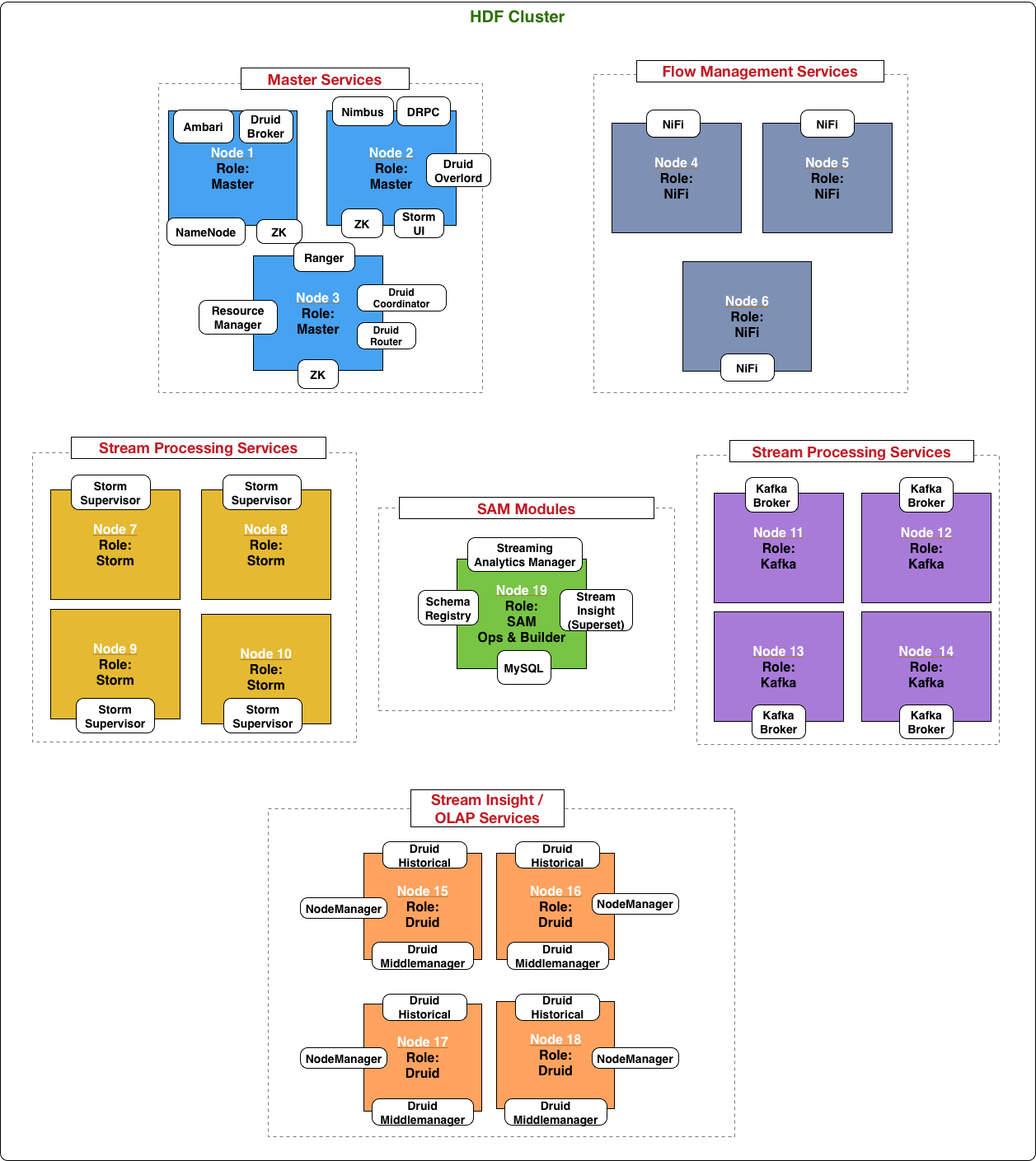Chapter 1. Deployment Scenarios
Identify your Deployment Scenarios
Depending on your use case, your deployment scenario for installing and configuring HDF components is different. These scenarios are covered in the following table.
| Scenario | Deployment Scenario | Scenario Steps |
|---|---|---|
| Installing HDF Services on a New HDP Cluster |
This scenario applies to you if you are both an HDP and HDF customer and you want to install a fresh cluster of HDP and add HDF services. The stream processing components include the new Streaming Anlatyics Manager (SAM) and all of its modules. This includes installing the technical preview version of SAM's Stream Insight module which is powered by Druid and SuperSet. This requires that you install both an HDF and an HDP cluster. |
|
| Installing an HDF Cluster |
You want to install the entire HDF platform consisting of all flow management and stream processing components on a new cluster. The stream processing components include the new Streaming Anlatyics Manager (SAM) modules that are GA. This includes the SAM's Stream Builder and Stream Operations modules but does not include installing the technical preview version of SAM's Stream Insight module which is powered by Druid and SuperSet. This requires that you install an HDF cluster. |
|
| Installing HDF Services on an Existing HDP Cluster |
You have an existing HDP cluster with Storm and or Kafka services and want to install NiFi or SAM’s modules on that cluster. This requires that you upgrade to the latest version of Ambari and HDP, and use Ambari to add HDF services to the upgraded HDP cluster. |
|
|
Performing any of the above deployment scenarios using a local repository. See Using Local Repositories in the instructions appropriate for your scenario. |
Local repositories are frequently used in enterprise clusters that have limited outbound internet access. In these scenarios, having packages available locally provides more governance, and better installation performance. This requires that you perform several steps to create a local repository and prepare the Ambari repository configuration file. |
|
HDF Cluster Types and Recommendations
| Cluster Type | Description | Number of Nodes | Node Specification | Network |
|---|---|---|---|---|
| Single VM HDF Sandbox | Evaluate HDF on local machine. Not recommended to deploy anything but simple applications. | 1 VM | At least 4 GB RAM | |
| Evaluation Cluster |
Evaluate HDF in a clustered environment. Used to evaluate HDF for simple data flows and streaming applications. | 3 VMs/Nodes |
| |
| Small Development Cluster | Use this cluster in development environments. | 6 VMs/Nodes |
| |
| Medium QE Cluster | Use this cluster in QE environments. | 8 VMs/Nodes |
| |
| Small Production Cluster | Use this cluster in small production environments. | 15 VMs/Nodes |
| 1 GB Bonded Nic |
| Medium Production Cluster | Use this cluster in a medium production environment. | 24 VMs/Nodes |
| 10 GB Bonded Nic |
| Large Production Cluster | Use this cluster in a large production environment. | 32 VMs/Nodes |
| 10 GB Bonded Nic |
More Information
Production Cluster Guidelines
General guidelines for production guidelines for service distribution:
NiFi, Storm and Kafka should not be collocated on the same Node/VM.
NiFi, Storm and Kafka have at least a dedicated 3 Node ZK cluster.
If HDF’s SAM is being used in an HDP cluster, SAM should not installed on the same node as Storm worker node.
The below diagram illustrates how services could be spread out for small production cluster across 15 nodes.

Hardware Sizing Recommendations
Recommendations for Kafka
Kafka Broker Node: 8 core, 64-128GB RAM, 2+ 8TB SAS/SSD disk, 10Gige Nic.
Minimum of 3 Kafka Broker Nodes
Hardware Profile: More RAM and faster speed disks are better, 10Gige Nic is ideal
75 MB/sec per node is a conservative estimate (can go much higher if more RAM and reduced lag between writing/reading and therefore 10GB Nic is required).
With a minimum 3 node cluster, you can expect 225 MB/seccond data transfer.
Further sizing can be done as follows. Formula: num_brokers = desired_throughput(MB/sec) / 75
Recommendations for Storm
Storm Worker Node: 8 core, 64 GB RAM, 1 Gige Nic
Minimum of 3 Storm worker nodes
Nimbus Node: Minimum 2 nimbus nodes, 4 core, 8 GB RAM
Hardware profile: disk io not that important, more cores are better.
50 MB/sec per node with low to moderate complexity topology reading from Kafka and no external lookups. Medium to high complexity topologies may see reduced throughput.
With a minimum 2 nimbus, 2 worker cluster, you can expect to run 100 MB/sec of low to medium complexity topology.
Further sizing can be done as follows. Formula: num_worker_nodes = desired_throughput(MB/sec) / 50
Recommendations for NiFi
NiFi is designed to take advantage of:
all the cores on a machine
all the network capacity
all the disk speed
many GB of RAM (though usually not all) on a system
Hence is important that NiFi be running on dedicated nodes. The below are the recommended server and sizing specs for NiFi
Minimum of 3 nodes
8+ cores per node (more is better)
6+ disks per node (SSD or Spinning)
At Least 8 GB
| If you want … | Recommended hardware sizing ... |
|---|---|
| 50 MB/second sustained throughput and thousands of events per second |
|
| 100 MB/second sustained throughput and tens of thousands of events per second |
|
| 200 MB/second sustained throughput and hundreds of thousands of events per second |
|
| 400 - 500 MB/second sustained throughput and hundreds of thousands of events per second |
|

